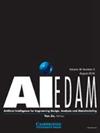基于粒子群优化和递归动态神经网络的硬车削多性能优化
IF 2.3
3区 工程技术
Q3 COMPUTER SCIENCE, ARTIFICIAL INTELLIGENCE
Ai Edam-Artificial Intelligence for Engineering Design Analysis and Manufacturing
Pub Date : 2022-09-19
DOI:10.1017/S0890060422000087
引用次数: 3
摘要
提出了一种将粒子群优化算法(PSO)与递归动态神经网络(RDNN)相结合的混合优化方法,即PSO-RDNN算法,用于淬硬aisid2精车削加工参数的多性能优化。利用加权和技术解决了建议的优化问题。包括切削速度和进给速度在内的工艺参数经过优化,以最大限度地降低操作成本,最大化刀具寿命,并生产具有可接受表面粗糙度的零件。基于实验结果,建立了两种神经网络模型,用于预测加工过程中刀具刃口磨损和表面粗糙度。基于训练神经网络和结构化混合算法,获得了最优切削参数。训练后的神经网络预测翼面磨损和表面粗糙度的决定系数分别为R2 = 0.9893和R2 = 0.9879,证明了训练后的神经网络模型在实际工业应用中的有效性。此外,所提供的方法返回一个帕累托最优图,它代表了几种不同切割条件下的优化切割变量。本文章由计算机程序翻译,如有差异,请以英文原文为准。
A hybrid particle swarm optimization and recurrent dynamic neural network for multi-performance optimization of hard turning operation
Abstract In the present work, a new hybrid approach combining particle swarm optimization (PSO) algorithm with recurrent dynamic neural network (RDNN), which is described as PSO-RDNN algorithm, is proposed for multi-performance optimization of machining parameters in finish turning of hardened AISI D2. The suggested optimization problem is solved using the weighted sum technique. Process parameters including cutting speed and feed rate are optimized for minimizing operation cost, maximizing tool life, and producing parts with acceptable surface roughness. Based on experimental results, two neural network models were developed for predicting tool flank wear and surface roughness during the machining process. Based on trained neural networks and structured hybrid algorithm, optimum cutting parameters were obtained. The coefficient of determination for trained neural networks was calculated as R2 = 0.9893 and R2 = 0.9879 for predicted flank wear and surface roughness, respectively, which proves the efficiency of trained neural models in real industrial applications. Furthermore, the offered methodology returns a Pareto optimality graph, which represents optimized cutting variables for several various cutting conditions.
求助全文
通过发布文献求助,成功后即可免费获取论文全文。
去求助
来源期刊
CiteScore
4.40
自引率
14.30%
发文量
27
审稿时长
>12 weeks
期刊介绍:
The journal publishes original articles about significant AI theory and applications based on the most up-to-date research in all branches and phases of engineering. Suitable topics include: analysis and evaluation; selection; configuration and design; manufacturing and assembly; and concurrent engineering. Specifically, the journal is interested in the use of AI in planning, design, analysis, simulation, qualitative reasoning, spatial reasoning and graphics, manufacturing, assembly, process planning, scheduling, numerical analysis, optimization, distributed systems, multi-agent applications, cooperation, cognitive modeling, learning and creativity. AI EDAM is also interested in original, major applications of state-of-the-art knowledge-based techniques to important engineering problems.

 求助内容:
求助内容: 应助结果提醒方式:
应助结果提醒方式:


